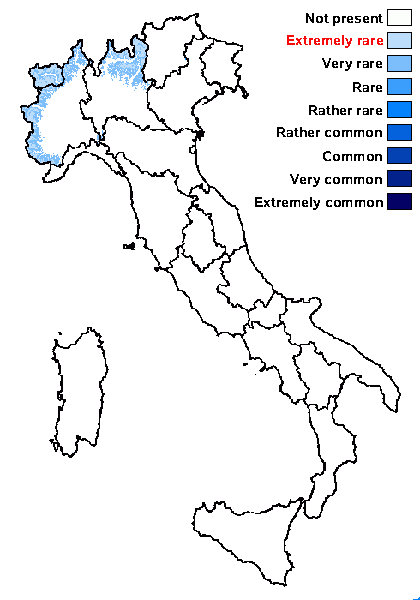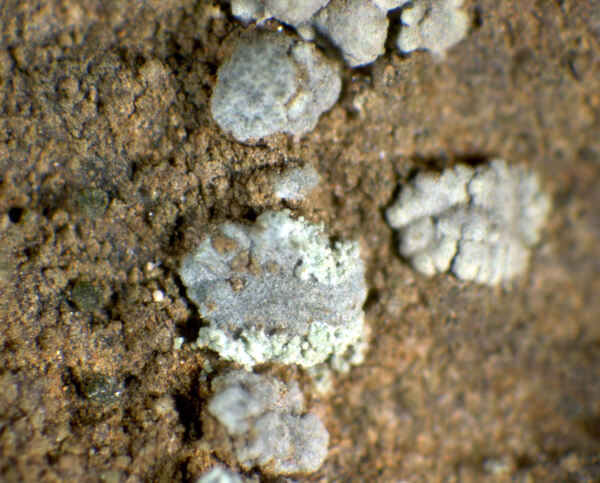Lecanora handelii J. Steiner
in Handel-Mazzetti, Ann. naturhist. Hofmus. Wien, 23: 119, 1909.
Synonyms:
Distribution: N - Lomb (Nascimbene 2006), Piem, VA (Piervittori & Isocrono 1999).
Description: Thallus crustose, episubstratic, of dispersed to contiguous, flat to usually convex, grey-green to yellowish grey areoles often developing on a black hypothallus, sorediate, the soredia whitish, grey-green or blue-grey, 20-30 μm thick, mainly arising from the margins of the areoles, later covering the whole surface. Medulla I-. Apothecia very rare, lecanorine, 0.2-0.5 mm across, sessile, with a pale reddish brown, sometimes blue-black-pruinose disc, and a persistent, not or only weakly raised, entire thalline margin. Epithecium colourless to pale yellowish brown, without crystals; hymenium colourless, 50-65 μm high; paraphyses branched and anastomosing, 1.5-2.5 μm thick, the apical cells not or only slightly swollen; hypothecium colourless. Asci 8-spored, clavate, Lecanora-type. Ascospores 1-celled, hyaline, ellipsoid, 8-13 x 5-7 μm. Photobiont chlorococcoid. Spot tests: thallus K-, C-, KC- or KC+ faintly yellow, P-, UV+ dull orange. Chemistry: usnic acid, zeorin.Note: on steeply inclined to rain-sheltered surfaces of metal-rich siliceous rocks in upland areas. The record from Campania (see Nimis 1993: 353) requires confirmation, and is not accepted here.
Growth form: Crustose
Substrata: rocks
Photobiont: green algae other than Trentepohlia
Reproductive strategy: mainly asexual, by soredia, or soredia-like structures (e.g. blastidia)
In underhangs rarely wetted by rain
Species of metal-rich rocks
Commonnes-rarity: (info)
Alpine belt: extremely rare
Subalpine belt: very rare
Oromediterranean belt: absent
Montane belt: very rare
Submediterranean belt: absent
Padanian area: absent
Humid submediterranean belt: absent
Humid mediterranean belt: absent
Dry mediterranean belt: absent

Predictive model
Herbarium samples
Growth form: Crustose
Substrata: rocks
Photobiont: green algae other than Trentepohlia
Reproductive strategy: mainly asexual, by soredia, or soredia-like structures (e.g. blastidia)
In underhangs rarely wetted by rain
Species of metal-rich rocks
Commonnes-rarity: (info)
Alpine belt: extremely rare
Subalpine belt: very rare
Oromediterranean belt: absent
Montane belt: very rare
Submediterranean belt: absent
Padanian area: absent
Humid submediterranean belt: absent
Humid mediterranean belt: absent
Dry mediterranean belt: absent

Predictive model
| Herbarium samples |
 INDEX FUNGORUM
INDEX FUNGORUM
 GBIF
GBIF
 DOLICHENS
DOLICHENS



